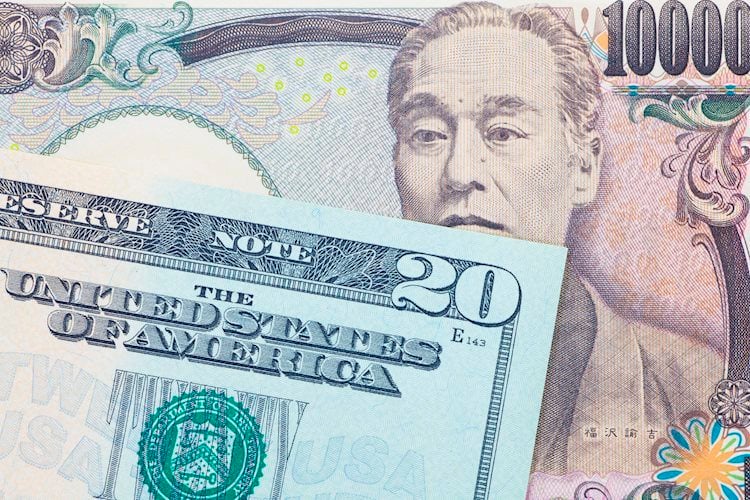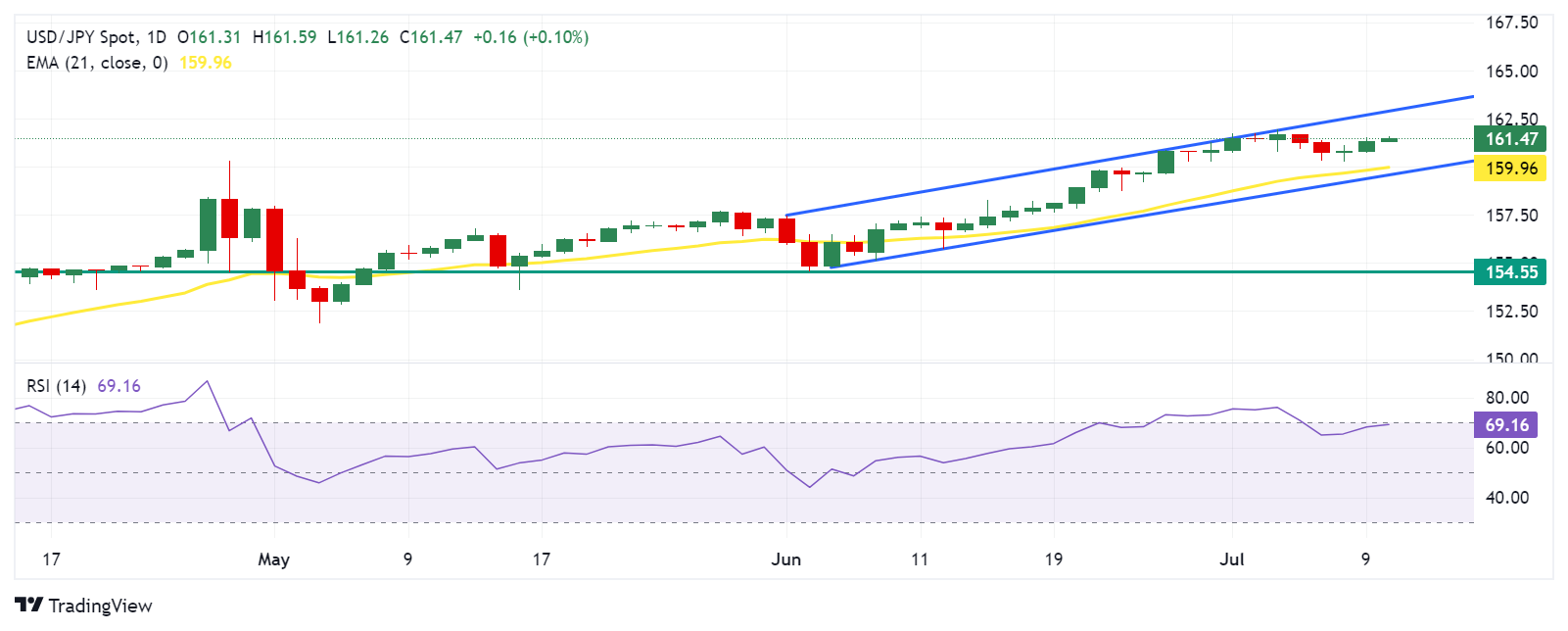- The Japanese Yen defends gains as the US Dollar turns south ahead Fed Chair Powell’s second testimony.
- Powell stated that a rate cut is not appropriate until the Fed gains confidence that inflation is moving toward 2%.
- The Bank of Japan is poised to assess a viable strategy for scaling back its government bond purchases.
The Japanese Yen (JPY) sticks to mild gains against the US Dollar early Wednesday, in the face of the latest Reuters report on potential economic revisions by the Bank of Japan (BoJ) at its July meeting. Reuters reported on Wednesday, citing unnamed sources, the Bank of Japan will likely trim this year’s economic growth forecast and project inflation will stay around its 2% target in coming years at its meeting this month.
USD/JPY is reversing a part of the previous upsurge, driven by a firmer US Dollar (USD), following Federal Reserve Chairman Jerome Powell’s testimony before the US Senate. Powell noted improved inflation figures but maintained the Fed’s cautious approach.
Meanwhile, the BoJ may raise interest rates during its July meeting and unveil plans to taper its bond purchases. On Tuesday, Japan’s Finance Minister Shunichi Suzuki underscored the significance of maintaining fiscal discipline to bolster confidence in long-term fiscal health. Suzuki also mentioned monitoring closely the discussions at the BoJ meeting concerning the bond market, as reported by Reuters.
Traders anticipate several key events in the financial markets. These include Fed Chair Jerome Powell’s second semi-annual testimony, speeches by Fed officials Michelle Bowman and Austan Goolsbee, and the release of US Consumer Price Index (CPI) data scheduled for Thursday.
Daily Digest Market Movers: Japanese Yen declines due to the cautious stance of Fed’s Powell
- Japan’s Producer Price Index (YoY) rose by 2.9% in June, accelerating from an upwardly revised 2.6% increase in the previous month, in line with market expectations. This marks the 41st consecutive month of rise in producer inflation and represents the highest level since August 2023.
- Fed Chair Jerome Powell stated in his Congressional testimony on Tuesday, “More good data would strengthen our confidence in inflation.” Powell emphasized that a “Policy rate cut is not appropriate until the Fed gains greater confidence that inflation is headed sustainably toward 2%.” He also noted that “first-quarter data did not support the greater confidence in the inflation path that the Fed needs to cut rates.”
- According to a Bloomberg report on Tuesday, the Bank of Japan is conducting three in-person meetings with banks, securities firms, and financial institutions over the next few days. The purpose of these meetings is to assess a feasible pace for scaling back its purchases of Japanese Government Bonds.
- The Japanese Yen struggles due to overseas asset purchases by Japanese individuals through the newly revamped tax-free investment scheme, the Nippon Individual Savings Account (NISA) program. According to Nikkei Asia, the scale of these purchases is expected to exceed the country’s trade deficit during the first half of this year.
- Japan’s Ministry of Finance reported on Monday that Japanese investment trust management companies and asset management firms bought ¥6.16 trillion ($38 billion) more in offshore equities and investment fund shares than they sold during the first six months of the year.
- On Monday, the Bank of Japan (BOJ) maintained its economic assessment for five of Japan’s nine regions in its latest ‘Sakura Report’. The assessment for two regions was raised, while it was lowered for another two regions in the report released on Monday. Regarding price trends, the BoJ noted that many regions report wage hikes spreading among smaller firms.
Technical Analysis: USD/JPY keeps range near 161.50
USD/JPY trades around 161.50 on Wednesday. The pair is maintaining its upward trajectory within an ascending channel pattern, suggesting a bullish bias according to daily chart analysis. Adding to this bullish outlook, the 14-day Relative Strength Index (RSI) remains above the 50 level, reinforcing the strength of the upward trend.
Looking ahead, the USD/JPY pair may target a critical resistance level near 162.70, positioned at the upper boundary of the ascending channel. A successful breakout above this level could bolster bullish sentiment, potentially propelling the pair toward the psychological resistance at 163.00.
On the downside, initial support for the USD/JPY pair is anticipated around the 21-day Exponential Moving Average (EMA) at 159.96. A breach below this level might exert pressure, prompting a test of the lower boundary of the ascending channel around 159.60. Further decline below this channel support could lead the pair toward the vicinity of June’s low at 154.55.
USD/JPY: Daily Chart
Economic Indicator
Fed’s Chair Powell testifies
Federal Reserve Chair Jerome Powell testifies before Congress, providing a broad overview of the economy and monetary policy. Powell’s prepared remarks are published ahead of the appearance on Capitol Hill.
Next release: Wed Jul 10, 2024 14:00
Frequency: Irregular
Consensus: –
Previous: –
Source: Federal Reserve
Inflation FAQs
Inflation measures the rise in the price of a representative basket of goods and services. Headline inflation is usually expressed as a percentage change on a month-on-month (MoM) and year-on-year (YoY) basis. Core inflation excludes more volatile elements such as food and fuel which can fluctuate because of geopolitical and seasonal factors. Core inflation is the figure economists focus on and is the level targeted by central banks, which are mandated to keep inflation at a manageable level, usually around 2%.
The Consumer Price Index (CPI) measures the change in prices of a basket of goods and services over a period of time. It is usually expressed as a percentage change on a month-on-month (MoM) and year-on-year (YoY) basis. Core CPI is the figure targeted by central banks as it excludes volatile food and fuel inputs. When Core CPI rises above 2% it usually results in higher interest rates and vice versa when it falls below 2%. Since higher interest rates are positive for a currency, higher inflation usually results in a stronger currency. The opposite is true when inflation falls.
Although it may seem counter-intuitive, high inflation in a country pushes up the value of its currency and vice versa for lower inflation. This is because the central bank will normally raise interest rates to combat the higher inflation, which attract more global capital inflows from investors looking for a lucrative place to park their money.
Formerly, Gold was the asset investors turned to in times of high inflation because it preserved its value, and whilst investors will often still buy Gold for its safe-haven properties in times of extreme market turmoil, this is not the case most of the time. This is because when inflation is high, central banks will put up interest rates to combat it. Higher interest rates are negative for Gold because they increase the opportunity-cost of holding Gold vis-a-vis an interest-bearing asset or placing the money in a cash deposit account. On the flipside, lower inflation tends to be positive for Gold as it brings interest rates down, making the bright metal a more viable investment alternative.

